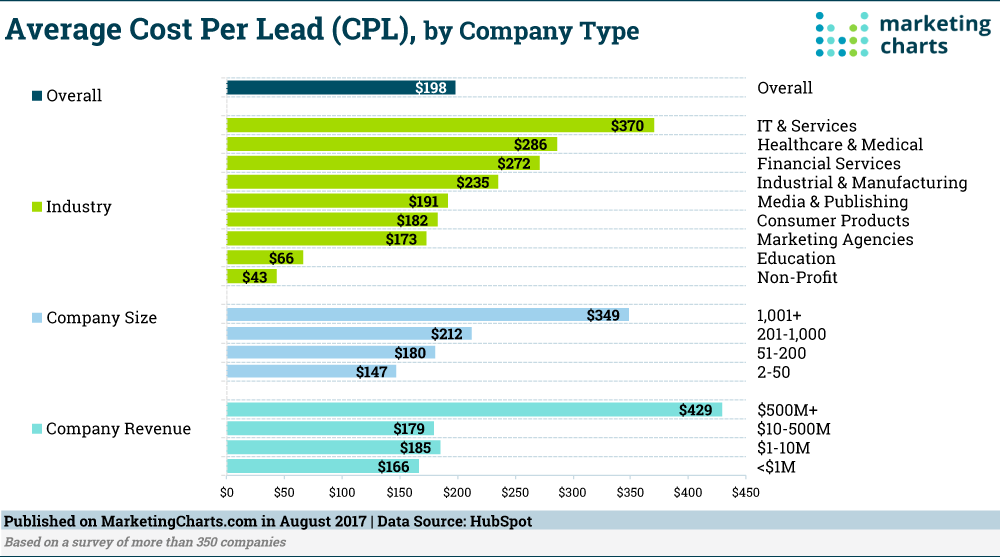4 Different Ways to Work Out Your Cost Per Lead in Different Situations
Generating leads is essential for any business, and yet your efforts must also be cost-effective or else they won’t be worthwhile.
Calculating cost per lead to justify or challenge the expenses involved is complex, so here are a few ways to work this out depending on the approach you’re using.

Stat Source: Hubspot.com
Many modern businesses have a social media marketing strategy in place to connect with existing customers and also generate leads via popular online platforms.
Obviously your budget for this strand of your broader marketing drive will be divided between user engagement, brand building, and lead generation, amongst other things.
The good news is that it’s fairly straightforward to establish costs for each lead generated through your social presence so long as you mix up your content and include posts that are geared towards earning interactions from newcomers, not just loyal followers.
Targeting the right platforms and using lead magnet offers will then let you analyze those clicks and conversions you receive, creating a more precise breakdown of generation costs, rather than requiring you to use an all-encompassing approach. Dividing the marketing spend for these particular campaigns by the number of leads generated will give you your cost per lead.
Understanding Pricing Plans for Popular Software, e.g. Salespanel, ZoomInfo, Clearbit, etc.
You can’t make accurate estimations of lead generation costs if you aren’t factoring in the price you pay for any software services you rely upon for your sales and marketing efforts.
Sometimes this is made trickier by the fact that pricing plans are not always that transparent, which can leave you scratching your head. Not every tool that can assist you with lead generation has transparent pricing like Salespanel.
Thankfully there are third-party sites that provide info on things like ZoomInfo pricing plans, breaking down the details and letting you work out what proportion of your lead generation costs are taken up by software alone.
This is doubly useful as it may bring up the salient point that your software costs are outweighing the benefits they bring in terms of winning over new customers. If a platform is not serving you in an efficient way, it may need to be eliminated from your budget, and replaced with a more affordable alternative.
Exploring Landing Page Creation
Another facet of lead generation that has to be scrutinized in an online marketing scenario is what it costs to create, implement, maintain and monitor landing pages.
The first part of the lead generation journey often occurs off-site, whether that’s via a social post, a PPC ad, or even a print media promotion.
Once prospects end up on your landing pages, the real work to bring them on board can begin, and so the price that’s paid to optimize this experience has to be covered by your calculations.
Things can get more expensive if you set up separate landing pages to track clicks and conversions from different ad formats and inbound platforms. And again, your eye needs to be on the budget throughout, because a failure to wring value from this aspect of your marketing operations will have a knock-on effect.
It’s sometimes useful to work out your cost per lead based on landing page outlay alone. Seeing this in isolation, as well as proportionally to other expenditures, should spur you to find efficiency opportunities and follow the data to implement improvements.
Appreciating Average Transaction Values
At this point, it’s worth remembering that the cost per lead calculation is different to the price you pay for customer acquisition.
Lead generation might just mean getting a prospect to sign up to your mailing list, whereas only those leads that convert to paying customers can be counted in acquisition stats. Even so, lead generation has to be viewed through the lens of average transaction values to determine whether costs are sustainable or untenable.
The smaller the average amount a customer pays to procure goods or services from your business, the lower your cost per lead must be. Even if you have a high volume of sales, excessive lead generation costs will compromise profitability.
On the other hand if you handle fewer transactions but each one has a much higher value attached to it on average, you can afford to spend more on bringing fresh leads to your business.
The Bottom Line
While it’s certainly possible to simply take what you spend on marketing and divide this by the number of leads you generate in a given period to get a rough estimate of the cost per lead, this isn’t very useful for enacting meaningful, positive change in your tactics going forward.
It’s better to break things down across the platforms you occupy and the campaigns you run, and always be aware of the ebb and flow of marketing dollars and new customers so that your strategies aren’t wasteful.
Sell more, understand your customers’ journey for free!
Sales and Marketing teams spend millions of dollars to bring visitors to your website. But do you track your customer’s journey? Do you know who buys and why?
Around 8% of your website traffic will sign up on your lead forms. What happens to the other 92% of your traffic? Can you identify your visiting accounts? Can you engage and retarget your qualified visitors even if they are not identified?


